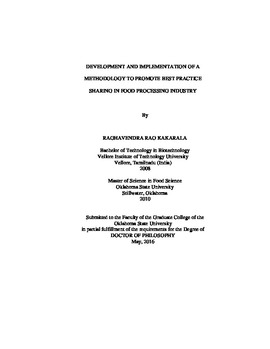| dc.contributor.advisor | Bowser, Tim | |
| dc.contributor.author | Kakarala, Raghavendra Rao | |
| dc.date.accessioned | 2017-02-22T22:09:42Z | |
| dc.date.available | 2017-02-22T22:09:42Z | |
| dc.date.issued | 2016-05 | |
| dc.identifier.uri | https://hdl.handle.net/11244/48821 | |
| dc.description.abstract | Safety and quality of foods have been a growing global concern not only because of the continuing importance of public health but also the significant financial impact on the industry due to food safety and quality issues. Third-party audits, regulatory inspections, and customer audits encourage food safety representatives in food processing sector to meet regulatory and customer requirements to ensure safety and quality of food products whereas internal audits help for self-assessment of food safety systems. Although these aspects have been standard practices in the food industry, there is a need for tools to empower the food sector in diagnosing and improving their FSMS by promoting best practice sharing. With the intention of improving knowledge and awareness of food safety and quality practices, enhancing the knowledge and understanding continuous improvement programs with regard to food safety and quality, Oklahoma Audit Alliance (OAA) was formed. The underlying agenda of the audit alliance was to promote best practice sharing within the food industry in the state of Oklahoma. OAA consists of participants from food companies, students, and other food safety professional from Oklahoma. Appropriate training was provided to the audit alliance members along with the necessary tools to participation organizations and conduct food safety, product quality and continuous improvement focused audits. Kirkpatrick evaluation method was used to study the effectiveness of the program by measuring the increase in awareness, knowledge of food safety and quality as well as understanding continuous improvement programs. Mann-Whitney-Wilcoxon one-sided test was used to test the hypothesis. At P<0.05, it was observed that there was a significant increase in knowledge (P-value =0.024), awareness (P-value =0.043), and understanding continuous improvement aspects of food safety and quality (P value =0.00003) by participating in OAA program. This justifies that a knowledge transfer has indeed occurred by making food safety professionals audit different companies and thus promoting best practice sharing. | |
| dc.format | application/pdf | |
| dc.language | en_US | |
| dc.rights | Copyright is held by the author who has granted the Oklahoma State University Library the non-exclusive right to share this material in its institutional repository. Contact Digital Library Services at lib-dls@okstate.edu or 405-744-9161 for the permission policy on the use, reproduction or distribution of this material. | |
| dc.title | Development and implementation of a methodology to promote best practice sharing in food processing industry | |
| dc.contributor.committeeMember | McGlynn, William G. | |
| dc.contributor.committeeMember | Rayas-Duarte, Patricia | |
| dc.contributor.committeeMember | DeYong, Camille F. | |
| osu.filename | Kakarala_okstate_0664D_14582.pdf | |
| osu.accesstype | Open Access | |
| dc.type.genre | Dissertation | |
| dc.type.material | Text | |
| thesis.degree.discipline | Food Science | |
| thesis.degree.grantor | Oklahoma State University | |
